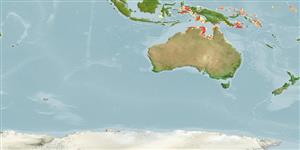>
Ovalentaria/misc (Various families in series Ovalentaria) >
Opistognathidae (Jawfishes)
Etymology: Opistognathus: Greek, opisthe = behind + Greek, gnathos = jaw (Ref. 45335); to the very elongate upper jaw of the type species of the genus, Opistognathus nigromarginatus (Ref. 128653); reticeps: Name from Latin words 'rete' for net, and 'ceps' for head, referring to the reticulated dorsum of the head, its distinguishing feature; noun in apposition..
Environment: milieu / climate zone / depth range / distribution range
Ecologia
marino demersale; distribuzione batimetrica 2 - 29 m (Ref. 76827). Tropical
Distribuzione
Stati | Aree FAO | Ecosystems | Presenze | Point map | Introduzioni | Faunafri
Western Pacific: Australia,
Size / Peso / Age
Maturity: Lm ? range ? - ? cm
Max length : 11.7 cm SL (female)
Short description
Morfologia | Morfometria
Spine dorsali (totale): 12; Raggi dorsali molli (totale): 15-16; Spine anali 2; Raggi anali molli: 13 - 14; Vertebre: 31. This species is distinguished by having a dorsal fin with 4 dark blotches, the first 2 extending onto distal half of fin; dorsum of head is reticulated; lateral line terminus below verticals from 10th spine to 3rd segmented dorsal-fin ray (Ref. 76827).
Benthic species which occurs inshore (Ref. 75154).
Life cycle and mating behavior
Maturità | Riproduzione | Deposizione | Uova | Fecundity | Larve
Smith-Vaniz, W.F., 2004. Descriptions of six new species of jawfishes (Opistognathidae: Opistognathus) from Australia. Rec. Aust. Mus. 56:209-224. (Ref. 76827)
IUCN Red List Status (Ref. 130435)
Threat to humans
Harmless
Human uses
Informazioni ulteriori
Nomi ComuniSinonimiMetabolismoPredatoriEcotossicologiaRiproduzioneMaturitàDeposizioneSpawning aggregationFecundityUovaEgg development
Age/SizeAccrescimentoLength-weightLength-lengthLength-frequenciesMorfometriaMorfologiaLarveDinamica popolazioni larvaliReclutamentoAbbondanzaBRUVS
BibliografiaAcquacolturaProfilo di acquacolturaVarietàGeneticaElectrophoresesEreditarietàMalattieElaborazioneNutrientsMass conversion
CollaboratoriImmaginiStamps, Coins Misc.SuoniCiguateraVelocitàModalità di nuotoArea branchialeOtolithsCervelliVista
Strumenti
Special reports
Download XML
Fonti Internet
Estimates based on models
Preferred temperature (Ref.
123201): 26.8 - 29.3, mean 28.2 °C (based on 319 cells).
Phylogenetic diversity index (Ref.
82804): PD
50 = 0.5000 [Uniqueness, from 0.5 = low to 2.0 = high].
Bayesian length-weight: a=0.00389 (0.00180 - 0.00842), b=3.12 (2.94 - 3.30), in cm total length, based on all LWR estimates for this body shape (Ref.
93245).
Trophic level (Ref.
69278): 3.5 ±0.6 se; based on size and trophs of closest relatives
Fishing Vulnerability (Ref.
59153): Low vulnerability (10 of 100).
